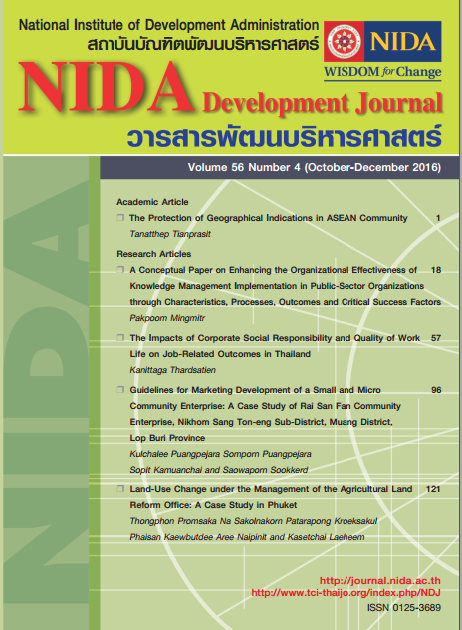Land-Use Change under the Management of the Agricultural Land Reform Office: A Case Study in Phuket
Main Article Content
Abstract
The aims of the research were to study how farmers use the land and become involved with agricultural land reform (ALR) in the Phuket province and to study guidelines for improving the regulations and management of ALRO4-01 land in the Phuket province. This research used qualitative methods, such as in-depth interviews with landowners involved in ALR, government officers of ALR in the Phuket province, and government officers of the agriculture department of the Phuket province. After collecting data in the first period, the researcher reported the information to an ALR expert. Determining the results involved the use of aerial photographs comparing land use between 2002 and 2007. An aerial photograph from 2002 shows a vacant area within the forest, as opposed to a 2007 photograph showing the vacant area covered by what almost look like rubber trees. The two patterns of the ALR area in the Phuket province were determined to be: 1) the areas designated for forestry preservation, for the community, and as an economic zone; and 2) the areas is not related to the economic zone. However, the areas of ALR that are far from the economic zone are nearly all vacant and feature a shrimp pond. Still, areas close to the economic zone include rented houses, restaurants, shops, rented rooms, and the Para rubber plantation. However, the survey found that the five land-use patterns were: 1) changed and no agricultural activity at the farm; 2) the owner rented out the area for a private tourism business; 3) a restaurant and shop located in the ALR area; 4) agricultural activity combined with a rented room or rented house in the area; and 5) the existence of agricultural activity on the farm. The five guidelines for land-use improvement in the ALR area in Phuket were: 1) Focus on the development and adjustment of farmer attitudes toward agricultural activity in the ALR area to improve the agriculture production system for high yield and high value; 2) improve the area to support eco-tourism activities; 3) farmers should manage the area, using some parts of the area for agriculture and others for supporting other businesses; 4) improve the Agriculture Land Reform Act, B.E. 2518 (ALRA1975) to support the present situation because it presently does not consider the dynamic of socio-economics; and 5) if ALRA1975 cannot be changed, make it illegal for the owner to use the Phayao model as a solution to the problem.
Article Details
Section
Articles

